Latest reviews
The Dungeon of Abkadev by Peter Konink is a Print & Play Adventure that closely mimics the gameplay of the Fighting Fantasy (FF) gamebook series. This adventure is based on the winning One-Page Dungeon 2016 of the same name.
The rules are very similar, including the magic, to the rules of the classic Citadel of Chaos which is the second in the FF series. Classic game mechanics are extended with random wandering monsters and the abstinence of roll or die situations. If you played any of those books before then you will understand it very quickly.
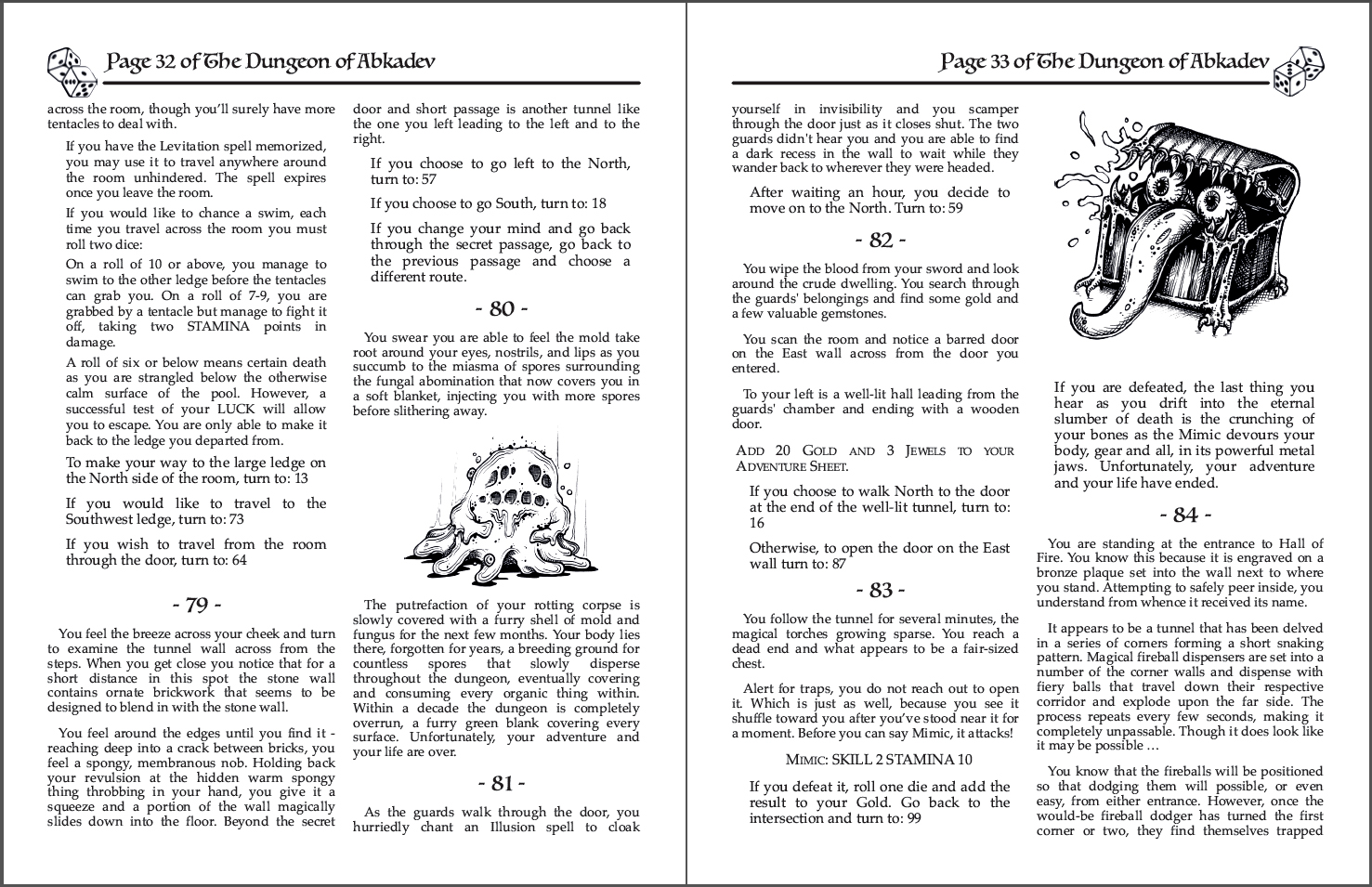
View inside the PDF file. (Credit: Pieter Konink. Fair use.)
While the story places you in the aftermath of a massive battle between two mighty wizards, the actual gameplay is just one big dungeon. You explore the dungeon to find the Tome of Vyzx for your wizard master. Even though the adventure consists only of 100 sections you get everything from monsters, traps, riddles to map drawing. The difficulty is high as it is impossible to obtain all three keys on the first try. Knowing traps and encounters before hand will help you to select the better routes and fitting magic spell. If you do not get all keys it is better to restart the adventure as back tracking is very tedious. Once you have collected all keys and finished the adventure there is little replay value.
The adventure contains several good illustrations that enrich the atmosphere. Together with the good layout and type setting the adventure looks really good when printed out at home. Dungeon of Abkadev is a great dungeon crawler every FF-fan should play.
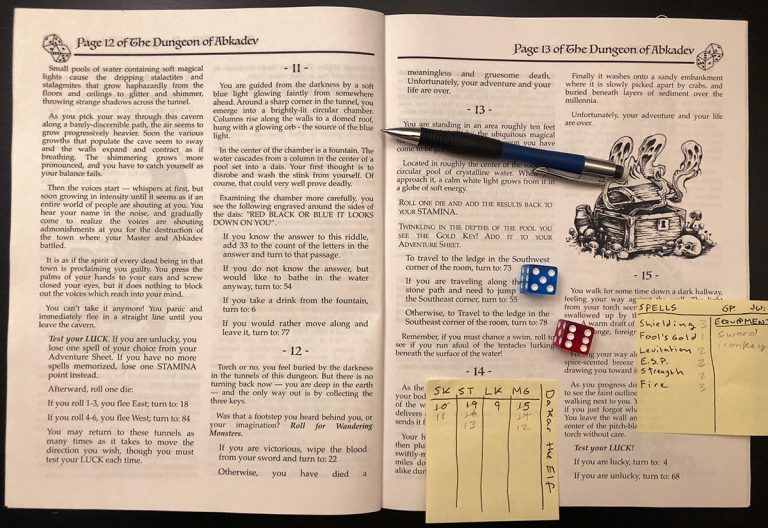
Printed copy, used for playing (Credit: Pieter Konink. Fair use.)

Triumph of Christianity over Paganism. 16th century fresco by Tommaso Laureti decorating the ceiling of the Constantine Hall in the Vatican Palace. (Credit: Jean-Pol GRANDMONT. License: CC-BY-SA.)
From the comfortable distance of a privileged life in the 21st century, it is perhaps easy to see that the Roman Empire was doomed. Having replaced oligarchy with permanent dictatorship, the empire sustained its ambitious civilization-building effort through slave labor and the spoils of expansionist wars. Internal unrest and foreign invasions were sure to follow. What role did religion play in this collapse?
Catherine Nixey’s book, The Darkening Age, makes the case that Christianity added fuel to the fire: quite literally in the form of book burnings or the melting down of statues, and figuratively through its embrace of a fanatical, exclusionary belief system that made it impossible to re-build or preserve a crumbling society.
Nixey knows her stuff; she studied Classics at Cambridge and subsequently worked as a Classics teacher for several years, but she is first and foremost a journalist, and her book tells history much in the way a writer like Erik Larson does: as a story with characters, sometimes picking the source that best fits the narrative, rather than attempting a neutral presentation of all possibilities of what happened.
In evidence of her thesis, Nixey marshals both “pagan” and Christian primary sources and cites recent modern research, such as Eberhard Sauer’s The Archaeology of Religious Hatred (Tempus, 2003) and Dirk Rohmann’s Christianity, Book-Burning and Censorship in Late Antiquity: Studies in Text Transmission (De Gruyter, 2016). The key themes of her book can be summarized as follows:
-
Early Christianity was a fanatical religion focused on martyrdom, suffering, and death.
-
While Christians were certainly persecuted at various times, the extent of that persecution was dramatically exaggerated.
-
As Christians gained power, they turned the tables and engaged in systematic destructions of temples, statues, and books, and forced conversion through acts of terror and murder.
-
The church did play an important role preserving what little ancient knowledge was preserved — but it did so extremely selectively (omitting materials considered too salacious, or those seen to contradict Christian doctrine). Effectively, much of the earlier culture was annihilated, including irreplaceable philosophical and scientific texts.
-
Rome’s polytheistic culture was sexually permissive and tolerant of argument and debate. Christian writers, in contrast, replaced debate with dogma. They railed against the “tyranny of joy” and laid the foundation for centuries of Christian sexual repression, associating pleasure with shame in ways that reverberate to this day.
You may think there is a consensus among modern historians about these claims, but there is not (this is, after all, a society still rooted in the very origins that are at issue). As Nixey acknowledges, many historians have painted a very different picture. Today you’re just as likely to read that polytheism simply grew out of fashion, or that the Dark Ages “weren’t really dark”, or that Christianity was a benign and civilizing influence during a chaotic time. Don’t even think to draw modern parallels!
Yet, as Nixey demonstrates, those parallels are all too obvious, and they are instructive, which is indeed why apologists prefer to ignore them. Nixey points out that Christian statue-smashers defaced the same beautiful statue of Athena at Palmyra that ISIS would completely obliterate more than a millennium and a half later, with similar “reasoning” (“The Prophet Muhammad commanded us to shatter and destroy statues.”).
Apologists claim that when early Christians burned books about “sorcery”, surely they contained just that—not science or philosophy! But we find no such nuance when we look to modern claims of “sorcery” by religious fanatics, such as when the Taliban sacked Afghanistan’s Meteorological Authority in 1996 because weather forecasting is, of course, sorcery. Christian fanatics who call Harry Potter “Witchcraft Repackaged” don’t draw the distinction between literature and religion.
Just as it did not in ancient Rome, tolerance rarely lasts long after religions gain political power. In the United States, where evangelical Christianity still has somewhat of an underdog status, religious extremists who oppose evolutionary theory merely ask that schools and universities “teach the controversy” (while funneling taxpayer funds to schools that teach only creationism). In Turkey, where Islamists have substantial political power, evolutionary theory was recently banned from textbooks.
In short, the counterarguments to Nixey’s thesis fall apart precisely when one observes and compares religious fanaticism in any of its modern manifestations that are more easily studied than texts from the 4th or 5th century (and less subject to manipulation, omission, and re-interpretation over the centuries). The fanaticism Nixey describes is, sadly, far from unique or remarkable, and its intellectual legacy is still with us today.
Learning from collapse
In The Queen of Spades, a short story with supernatural overtones, Alexander Pushkin wrote: “Two fixed ideas can no more exist together in the moral world than two bodies can occupy one and the same place in the physical world.“ By that standard, two ideas could not be more fixed than those of polytheism and monotheism. How does one tolerate the intolerant?
Christianity was not the only cult of its time that made singular claims to the truth; it was merely the one that ultimately prevailed. But far from being a force for peace or preservation, it added fuel to the fire of Rome’s—probably inevitable—collapse.
A fierce, hateful religion (and that is what this iteration of Christianity was) could never have gained such momentum in a healthy, stable society. But under conditions of instability and inequality, it accelerated and ultimately cemented the loss of a civilization. That is the key lesson to carry into the 21st century, and Nixey deserves much credit for writing an accessible book to do so.
Can you Brexit? is a rare genre mix of political satire and gamebook by the well-known Dave Morris and Jamie Thomson. The duo is known for the Fabled Lands gamebook series and more.

Book Cover (Credit: Dave Morris and Jamie Thomson. Fair use.)
The book puts the reader in the shoes of the Prime Minister (PM) of the United Kingdom first day after the Brexit vote till the bitter very end of the Brexit process. At least basic knowledge of the UK or the EU is required to follow the story even though the books goes into great length to explain the actual problems that need to be handled. These include the National Health Service (NHS), Exit Fee, Immigration, EU Trade Talks and Residency Rights. As PM, you cannot decide everything as you like. You have to consider not only the facts but also have to delegate decision-making, respect the party and popular opinion. The books make it very clear that this is the worst job you can have in current Europe.
While the actual Brexit is not yet the complete, the book allows the reader to follow alternative paths and already finish the Brexit in an alternative reality. For this alternative reality all names of political figures have been replaced with somewhat funny names. Everything is in the cards for the reader including political suicide to great disaster for Britain. As long as the real Brexit isn’t over, the replay value is high as you can play it again with current political progress in mind. The overall presentation is very dry with no illustrations. The gameplay requires keeping track of certain decisions and results in a lot or check boxes. No deice are required but a seldom coin toss will decide for you. The outcome of the story is base on four stats: Authority within the party, Economy of Britain, Goodwill of the EU and Popularity with the voters. Those can be increased with good decisions and very easily lost with any kind of backlash.
Can you Brexit without breaking Britain? It’s a difficult task and the book gives a very good glimpse into the process and facts behind the decision-making. It also makes very clear that Theresa May has the worst job any politician. Reading her memoirs and comparing it with these books a few years will be the only reason to replay it after Brexit. This book is for the political interested gamebook fans. For a gamebook beginner the story and presentation can be too dry to enjoy it at first.
Mit Flucht aus dem Dunkel entsteht 1984 der erste Band der Spielbuch-Reihe Einsamer Wolf von Joe Dever. Sie ist mit 10 Millionen verkauften Büchern ein der erfolgreichsten Solo-Abenteuer-Serien weltweit. Die hier vorliegende und erweiterte Neuauflage erscheint beim Mantikore-Verlag und unterscheidet sich deutlich von der Urfassung. Um an diesem Solo-Abenteuer Spaß zu haben, braucht man außer dem Buch selbst nur einen Bleistift und Radiergummi.
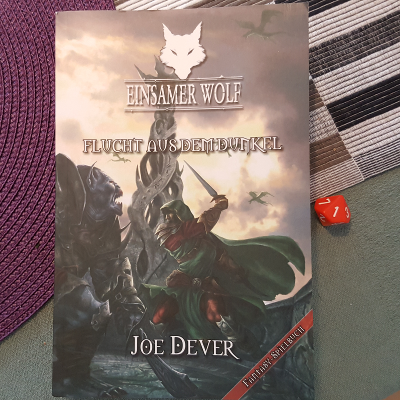
Bild des Buchs (Eigenes Werk. Lizenz: CC-BY-SA.)
Der Leser beginnt sein Abenteuer direkt mit dem Angriff der Schwarzen Lords auf die Abtei der Kai. In der Urfassung beginnt das Abenteuer erst nach der Zerstörung der Abtei und lässt den Leser im Unklaren über die grausamen Geschehnisse dort, die so in der Fantasie des Lesers stattfanden. Jetzt dient der Angriff als ein actionreicher Einstieg in die Fantasy-Sage und möglicherweise in das Medium der Spielbücher selbst. Der Ausgang ist vorgegeben, wie man sich in der Schlacht anstellt, ist der spannende Teil für den Spieler. Man reitet, kämpft und klettert durch die Abtei und macht sich mit den Mechaniken des Spielsystems vertraut. Dazu gehören Kämpfe, verwalten des Inventars und Kai-Fähigkeiten einsetzen.
Der Weg von der zerstörten Abtei dann hin zum König in Holmgard verlangt richtige Entscheidungen, um Erfolg zu haben. Fallen müssen erkannt und Gegner besiegt werden. Die Geschichte ist durchweg spannend, auch wenn klar ist, dass dieser Band nur der Einstieg in ein größeres Abenteuer ist. Die Welt von Magnamund zieht einen schnell in einen Bann, so dass sich der Leser heimisch fühlt auch ohne bekannte genre-typische Motive wie Zwerge oder Orks.
Das Kampfsystem erlaubt schnelle und zum Teil sehr schwere Kämpfe, die schnell verstanden und ausgewürfelt sind. Durch die verschiedenen Fähigkeiten, hat man gelegentliche Vorteil und kann einem sonst verschlossene Pfade und Gefahren erkunden. Zusammen mit der Wahl auf verschiedenen Wegen nach Holmgard zu gelangen, ist der Wiederspielwert hoch. Sollte man dem Zauberer Bandeon nicht begegnet sein, empfehle ich das Abenteuer noch einmal zu spielen. Die Illustrationen von Rich Longmore sind zweckmäßig, wobei einige Momente des Abenteuers toll eingefangen werden. Mit den düsteren und zum Teil unbehaglichen Illustration von Gary Chalk aus der Urfassung können sie dann nicht ganz mithalten. Die Deutsche Übersetzung erlaubt sich den einen oder anderen Patzer, trübt aber das Erlebnis nicht.
Mit Flucht aus dem Dunkel liegt ein gutes Spielbuch vor, dass man jedem Einsteiger aber auch altem Fan empfehlen kann. Leicht zu erlernen, viele Handlungsmöglichkeiten und die Aussicht auf viele weitere Abenteuer.
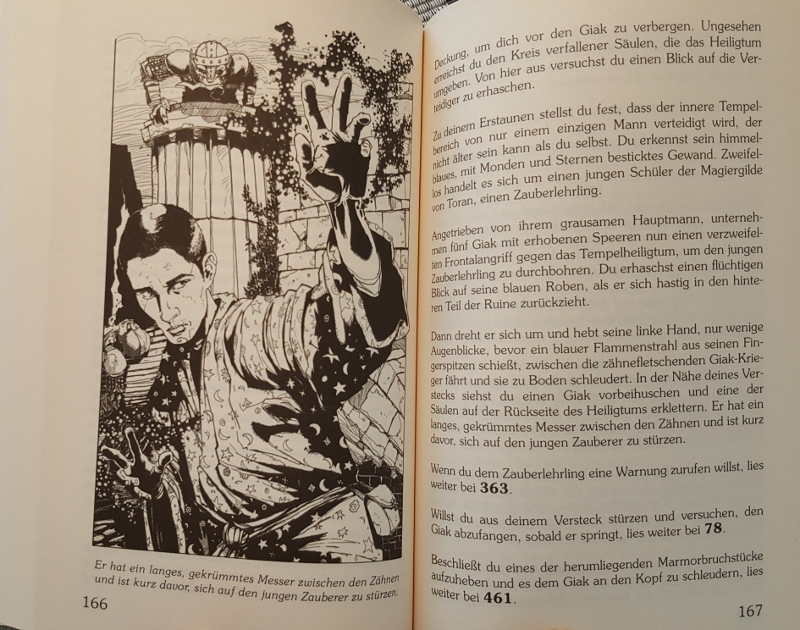
Buchinnere (Eigenes Werk. Lizenz: CC-BY-SA.)
This is a fork of the popular Maps.me Android app, which removes the nonfree bits and the ads, and is released on F-Droid. To me it looks and works better than OsmAnd, but it currently has a broken log in in OpenStreetMap, which is big problem for me as an editor, and it’s what keeps this from getting a perfect score.
Edit for clarification: it seems the aforementioned bug is not exclusive to this fork, happening also on Maps.me.
Un pub entre les stations de métro Porte Dauphine et Victor Hugo. Propose des plats du jour et des burgers à midi et le soir : le burger végétarien ainsi que celui au pesto sont particulièrement bons.
Petite terrasse sur le trottoir, agréable l’été. Souvent blindé le midi.
Night in the Woods is an adventure game available for virtually all platforms (as of this writing: Windows, macOS, Linux, PS4, Xbox One, Switch). The game mostly takes place from the perspective of college drop-out Mae Borowski, whose return to her hometown of Possum Springs leads to reunions, conflicts, weird dreams, and a gradually unfolding mystery.
The town is inhabited by anthropomorphic animals (and, oddly, by some actual animals); Mae herself is a 20-year-old cat. The player controls Mae in a manner similar to a jump-and-run game, but with the sense of safety of a point-and-click adventure. While there are areas of the game world that can be a bit tricky to reach, there is very little puzzle-solving.
From time to time, a scene turns into a mini-game (playing the bass guitar, stealing an item from a shop, hitting objects with a baseball bat). You often only get one shot at these games, and whether you succeed or fail will reveal small variations in the story.
While the story is more or less on rails, the game’s characters keep you engaged. There’s Mae’s old friend Gregg, a fox whose short attention span doesn’t seem to get in the way of his employment at the “Snack Falcon”. As time goes on, the depth of his love for his boyfriend, a bear named Angus, is revealed, who seems to be Gregg’s best hope of growing up.
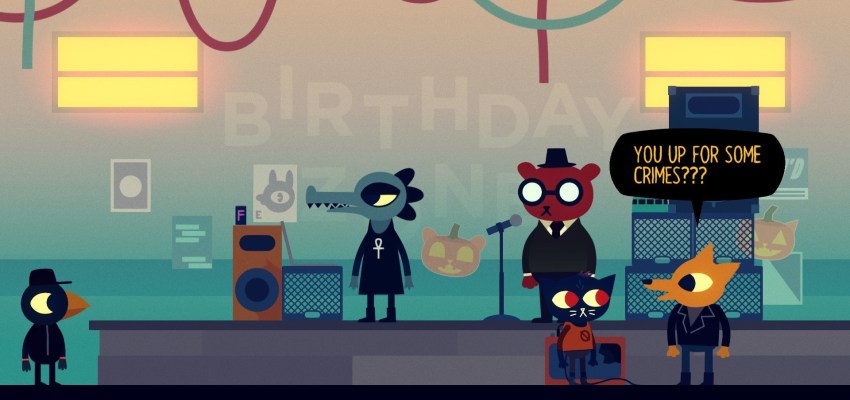
From left to right: Germ, Bea, Angus, Mae, and Gregg at band practice. (Credit: Infinite Fall. Fair use.)
There’s Beatrice “Bea” Santello, a goth who seems initially hostile but who opens up after Mae spends more time with her. And of course there are Mae’s parents, who struggle to get their daughter to tell them what exactly caused her to drop out of college.
When speaking with other characters, you are often given multiple dialog options, but what you can say is constrained by Mae’s perspective on the world as a 20-year-old with … issues. After many experiences, Mae automatically scribbles notes into her personal journal, which are observations like “GREGG RULZ OK” or “THOUGHT: THIS PLACE IS FALLING APART”, often accompanied by cartoons.
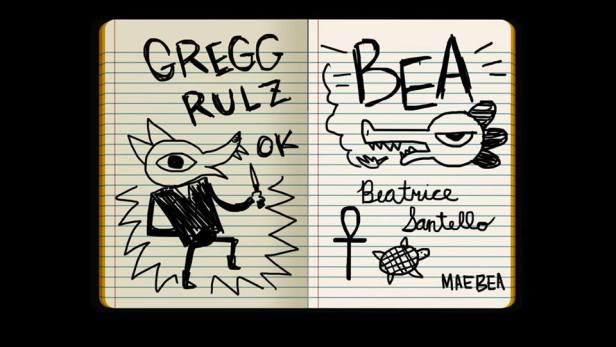
As the game progresses, Mae draws little notes in her journal. (Credit: Infinite Fall. Fair use.)
Over time, the mystery at the heart of the story gradually becomes apparent. Mae experiences weird dreams and a growing sense of anxiety, and she witnesses strange goings-on in Possum Springs. The ultimate “reveal” is less important than Mae’s struggle to come to terms with her own fragility. There are discussions of death and religion, but they are meditative, not proselytizing.
Night in the Woods is a gorgeous game: the characters, landscapes and animations are simple but beautiful, enriched by context-specific background music (listen to the soundtrack). The writing is terrific and the pacing is generally good; the early game can feel a bit drawn out.
The main controls are easy to master, though some of the mini-games can feel a bit unfair the first time around. You’ll probably get at least one replay out of the game, to discover hidden branches of the story you missed the first time around, and to master the various mini-games.
On the Nintendo Switch, which is the version we played, the load times can be a bit frustrating: going from one screen to another can trigger a five second “loading” animation, and it’s in the nature of the game’s controls that you might do so accidentally a few times.
The Verdict
I highly recommend giving this game a chance, unless you’re put off by some of the themes of young adult drama and prefer your games to be more challenging. Currently, the game goes for $20 on Steam, which is a decent price for the amount of content that’s packed in here. While the game is not without its minor frustrations, I would give it 4.5 out of 5 stars, rounded up.
Tiu nacia kongreso, kune kun junulara renkontiĝo, estis mia unua E-kunveno post Esperantistiĝo, kaj ĝi ege plaĉis al mi. La kongresejoj estis tre bonaj lokoj: la Memorejo de Kuritibo (kulturcentro en urbocentro) kaj apuda universitato nomata UNINTER. La organizado ŝajnis tre profesia, kaj mi laŭdas la Paranaa Esperanto-Asocio pro tio. Ankaŭ estis aliaj eventoj kiel kurado, ekskursoj, KER-ekzameno kaj interesaj kulturaj prezentaĵoj. Eta problemo estis, ke oni ne vere povis aŭdi la mikrofonsonon ĉe la Memorejo, do ni apenaŭ povus kompreni, ekzemple, pri Paulo Silas, Esperantista poeto omaĝita dum la evento.
Estis etaj loĝistikaj problemoj rilate al tempo de aktivitatoj, kaj mi ege malĝojis, ke oni informis pri la neokazo de kelkaj prelegoj tre malfrue, aŭ foje eĉ ne informis. Tiaj aferoj ja okazeblas, sed estus pli bone scii antaŭe. Alia plendeto estas, ke ĝi estis tro mallonga! Kongresoj daŭru minimume semajno, bonvole :)
Sed ĝenerale estis bonega etoso, almenaŭ inter la junuloj, kie mi ĉefe partoprenis, kaj la amikecojn oni ekkreas en tiuj lokoj multe pelas onin plue partopreni aliajn kongresojn kaj aktiviĝi por Esperanto. Do mi dankas BEL kaj BEJO por tiu oportuno!
Malgarantio: mi ricevis monan subtenon por partopreni la kongreson, kaj laboris kiel volontulo. Ankaŭ, la organizantoj petis ke mi verku raporton pri ĝi poste, do eblas, ke mia opinio iel favoremas ĝin, tamen mi kredas, ke la plejmulto da partoprenantoj havas similajn pozitivajn opiniojn pri ĝi.
Esse izakaya (espécie de boteco japonês) na Augusto Stellfeld é um espaço pequeno e aconchegante, com uma atmosfera muito autenticamente japonesa. O grande problema é o preço, que é bizarro; um simples espetinho de shiitake com quatro cogumelos já dá dez reais. Pedindo duas cervejas, dois espetinhos e um pires de raiz forte já passa dos oitenta reais. O atendimento também podia ser um pouco mais amigável.
Vale a pena conhecer, mas é inacessível pra maior parte das pessoas.
Esse restaurante é sensacional. O atendimento é bom, o espaço é bacana (um bonito casarão histórico em uma esquina do Largo da Ordem) mas o forte mesmo é a comida. Provei a esfirra, a coxinha e o enroladinho de salsicha, sendo esse último meu preferido. Eles também oferecem chocolates e sorvetes, tudo vegano. É incrível.
Como se não bastasse, o lugar é super barato. É o melhor de todos os mundos. A única coisa que pode melhorar é o buffet de almoço. Quando eu fui, era só arroz, feijão, duas opções de strogonoff vegano e batata palha. Faltou bastante opção. Mas como lanchonete, funciona super bem.
